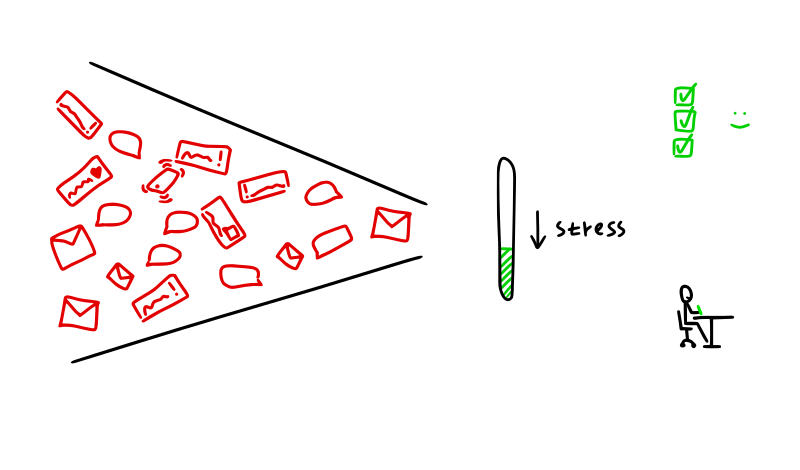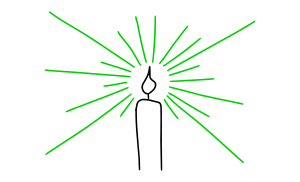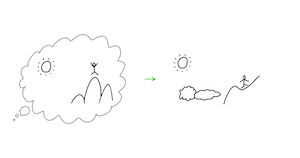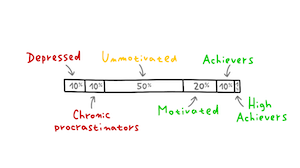What is addiction?
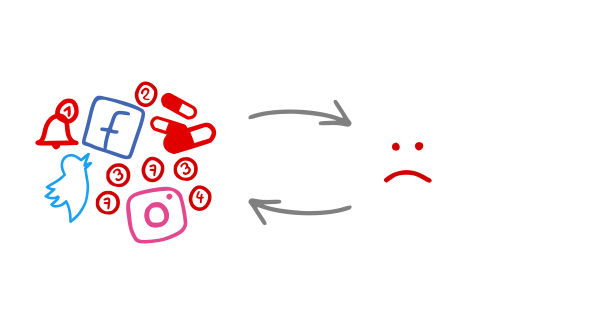
The simplest way of defining addiction is to say that you can’t control yourself and it has negative consequences in your life.
But it isn’t self-explanatory, so how do you know if someone is addicted?
How do you know if you’re addicted?
The first sign is a loss of control: you can’t stop doing what you’re doing, you don’t stop when you tell yourself you would.
However, this doesn’t mean you’re addicted - we can also get lost because an activity is so much fun.
People have fun all the time and they’re not addicted, so how do you spot the difference?
There are 3 other signs: First, the thing doesn’t bring you much fun anymore, and yet you still do it. When you’re addicted, you want something (crave it) but when you get it you don’t like it that much.
Second, you keep using the substance or doing the behavior even though it has negative consequences in your life.
Third, you crave the substance or behavior a lot while not doing it.
Why do people get addicted?
People look at addicts and don’t understand why they would want to endure such suffering.
However, addiction makes sense once you start seeing it as a way of dealing with stress. Addiction is a coping mechanism, a natural response to not knowing how to deal with stress.
When people are unable to deal with their negative emotions they often escape via addictive behaviors. Their brain quickly learns that when they feel negative emotions, they can simply go to the addictive behavior and feel better immediately.
This isn’t to blame anyone.
When reality is unbearable, addictive behavior can be the only light of joy in the world full of darkness.
Even though the addictive behavior usually makes the darkness ever darker.
If you think about it, it’s probably the most efficient way of managing your emotions when you don’t know how to manage emotions. When you feel terrible and there is something that makes you feel better immediately, you heavily discount the consequences it might have for you in the future.
There are 2 general ways of people becoming addicted:
Life sucks
For a person to become addicted you need[1]:
- A person that’s unable to deal with stress - generally
- A stressful situation - a trauma, a tragedy, or stressful life
- A product or a behavior that helps you escape the negative emotions
This model is good at explaining why people become addicted when their life isn’t good. It also explains why people continue being addicted when their addiction progresses.
It also makes you wonder why everyone isn’t addicted.
So the cycle looks like this:
Life sucks → substance or behavior helps you alleviate this → it teaches your brain to look toward this fix → in comparison to this fix, everything else is less satisfying → Life sucks even more → you start looking for a way to escape more…
Addiction is a vicious cycle. You get addicted because your reality sucks.
But because you’re addicted, it starts to suck even more.
However, not all people who become addicted run away from stress. Sometimes the high is just too good in comparison to regular life.
Life is normal
Here the cycle is a little bit different: Life is normal → drugs or certain behavior is much much better than normal life → continued usage changes your brain (more on this below) and your normal life starts to suck → addiction is now the escape from the life that sucks
Now, not everyone is addicted in the same way. It isn’t black or white - you’re addicted or you’re not. Instead, imagine a spectrum that shows how much a person is addicted. After it reaches a certain point, your brain isn’t functioning in a healthy way anymore, it’s regarded as a brain disease.
Addiction as a brain disease
The current paradigm that’s accepted by the majority of institutions is the brain disease model of addiction (BDMA).
Here’s the definition:[2]
Addiction is a treatable, chronic medical disease involving complex interactions among brain circuits, genetics, the environment, and an individual’s life experiences. People with addiction use substances or engage in behaviors that become compulsive and often continue despite harmful consequences.
Addiction differs in severity and only after a person reaches a certain threshold, they’re addicted, in the sense that we can call it a brain disease.
Brain disease meaning that the brain isn’t functioning in a healthy way anymore.
How addiction changes your brain
In the past, addiction was regarded as a moral failure, a choice, spiritual failure, etc. It was thought that everyone has free will and therefore addiction is a choice or something along that.
However, with the advancement of neuroscience, this was mostly debunked because there are structural changes in your brain during addiction that make a notion of free will look weak at best.
Previously, it was thought that you can only get addicted to substances but nowadays behaviors are also starting to get recognized and accepted… Behavioral addictions cause similar changes to the brain.
Generally, every addiction causes similar changes to your brain. Addiction hijacks your dopamine pathways and causes changes in the brain circuitry, which can be divided into 4 main categories[3] [4]:
- Sensitization towards craving
- Desensitization towards rewards
- Dysfunctional executive controls
- Dysfunctional stress circuits
Sensitization towards craving
Brain circuits become hyper-sensitive towards cues and memories related to the addictive behavior.
Remember that a release of a lot of dopamine (caused by drugs, games, social media, gambling) leads the brain to a state of rapid learning. It felt great, I want to do it again.
Anything—Where, with who, what you were doing—that is associated with the behavior or substance quickly becomes a cue that causes you to want it or even crave it.
Remember hearing a soundtrack from your favorite game? It brings back all the nostalgia because life was easy back then when you used to play this game.
Smoking cigarettes is probably one of the most addictive things because of the frequency of the behavioral cue → whenever you feel stressed, you smoke and it makes you feel better - the brain picks this pattern up really quickly and voilá you’re dependent on cigarettes.
For gaming, only 5 days of playing a game 2 hours per day lead to noticeable brain changes that sensitize your brain.[5]
Desensitization towards rewards
If we look at how dopamine works, it isn’t a neuromodulator of pleasure (it plays a role in pleasure as well) but it’s main role is to motivate you towards action.
When your brain is overstimulated by dopamine, it starts to dial down the dopamine receptors.
It’s the same process as:
If there’s too much light, you squint your eyes.
If your brain keeps receiving too much dopamine, the dopamine receptors downregulate. When this happens depends on frequency and intensity of the stimulation.
Drugs, video games, porn, or gambling produce more dopamine than what we would get naturally so they lead to dialed-down dopamine receptors.
You’re less sensitive to pleasure, and you need a higher dose of stimulation to achieve the same response.
This causes a huge problem because normal things are even less fun and whenever we don’t engage in the addictive behavior, life is insufferable.
In the past, scientists thought that the drug one was addicted to would cause total bliss, but it’s been debunked since then. Everything brings you less joy. You only crave the drug more (sensitization towards craving) but it doesn’t bring you more happiness. You crave it even more because everything else is suffering.
Most people who were heavily addicted talk about that in later phases, the drug wouldn’t bring them any bliss, but it was the only way of alleviating terrible feelings.
Wanting something isn’t liking it.
Dysfunctional executive controls
Because the dopamine pathways are altered, the executive system gets out of whack and your willpower and ability to self-control go down. Also, you’re unable to plan more complicated steps.
This doesn’t mean that the addicted person doesn’t have any ability to control themselves but it’s generally weaker.
Also, this hampers your decision making ability.
Dysfunctional stress circuits
The mediators of negative emotions like stress are also altered [6]. They don’t function in a normal way anymore.
This leads to becoming anxious or stressed easily.
This makes you crave the addictive behavior even more because you’re more susceptible to negative emotions.
Combination of all these 4 factors makes addiction such a nasty problem.
- You crave the drug or the behavior
- You enjoy everything else less
- You’re worse at controlling yourself
- Everything stresses you out more
The criticism of the model - it’s not really a brain disease
To be honest, I was already finished with writing this post but then I discovered a valid criticism of the brain disease model of addiction (BDMA)[7], so I decided to scrap the whole draft, went back to the drawing board, and had to read another few dozen scientific journals and 2 books so I could rewrite it.
The critics agree with the brain changes but they disagree with calling it a brain disease. They think about addiction as a learning process. According to them, addiction is a natural change in the brain occurring by being exposed to continued pleasure stimuli. [8]
It’s a predictable reorganization of the brain. Addiction is a super learning that happens to cope with negative emotions.
The critics acknowledge the merit of BDMA (2nd paradigm) because it helped shift the attention from calling addiction a moral failure (1st paradigm) but still think it’s not helpful. They call for creating a 3rd unifying paradigm.
Here are the most common criticism points:
1. The issue with calling it chronic
BDMA doesn’t explain why people who are heavily addicted recover out of the blue.
Also, If it’s chronic, how come the majority of people recover from addictions without any treatment?
Why do most people quit their addiction during their lifetime without any formal treatment?
Despite BDMA leading to the notion of no free will, there are cases when people recover altogether without any treatment.
2. Creating a stigma by calling it a disease
Critics of this model also think that calling addiction a brain disease stigmatizes the addicts. [9]
In culture, addiction isn’t portrayed accurately. The public thinks that addicts are wackos and in the short attention span culture, without any space for nuance there isn’t a room to explain what a disease is.
A good example is: look at what people think about calling obesity a disease. It’s mostly a laughing stock. The majority of people have no idea that by “obesity is a disease” is meant that people’s brain after a certain point isn’t functioning properly (it has the same similarities as addiction in hijacking the reward system).
3. Victimizing addicts
It victimizes the addicts because it implies: your brain is sick, you can treat it but you won’t ever be cured.
They argue this is unhelpful, it can cause people to think that there is no free will because their brain is “sick.” [11]
They think there is a choice in some cases - not to make addiction a moral problem but to show that it’s possible to recover fully - your brain isn’t chronically sick.
4. Calling it disease leads to the need for medication
This leads to overusing medication as a main way of treatment. It also leads to the majority of funding going towards this. [10]
The BDMA model leads to medical treatment (pills) as one of the first interventions - which in the case of behavior addictions isn’t viable
BDMA critics call for creating a 3rd paradigm because the current one is often simplified and often leads to considering the strong version (it’s a chronic disease that you can’t do much about) as the correct one.
It’s an interesting debate and currently, the 3rd paradigm has a more optimistic outlook on the next question which is: Can you recover from addiction?
Sources:
[1] https://www.nirandfar.com/addiction/
[2] https://www.asam.org/Quality-Science/definition-of-addiction
[3] https://www.pnas.org/content/108/37/15037.short
[4] https://www.ncbi.nlm.nih.gov/pmc/articles/PMC2948245/?tool=pubmed
[5] https://www.liebertpub.com/doi/10.1089/cyber.2015.0185
[6] https://www.ncbi.nlm.nih.gov/pmc/articles/PMC2819562/?tool=pubmed
[7] https://www.tandfonline.com/doi/full/10.1080/16066359.2017.1399659
[8] https://www.goodreads.com/en/book/show/23214265
[9] https://blogs.scientificamerican.com/observations/why-the-disease-definition-of-addiction-does-far-more-harm-than-good/#
[10] https://blogs.scientificamerican.com/observations/why-the-disease-definition-of-addiction-does-far-more-harm-than-good/#
[11] https://www.sciencedirect.com/science/article/pii/S235285321630013X#bb0110
